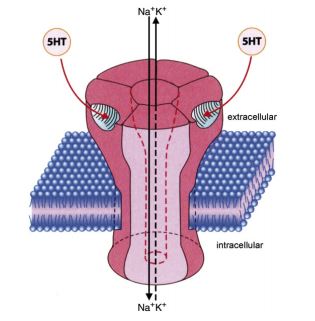Introduction of 5-HTR3D
5-hydroxytryptamine receptor 3D (5-HTR3D), alternatively known as serotonin receptor 3D, is one of several different subtypes of the receptor for serotonin (5-hydroxytryptamine), a biogenic hormone which acts as a neurotransmitter, a hormone, and a mitogen. The 5-HTR3D receptor belongs to the ligand-gated ion channel receptor superfamily and in humans is encoded by the HTR3D gene. The 5-HTR3D gene is shown to be absent from the rodent genome. 5-HTR3D in human is predominantly found in the liver, as well as adult and fetal colon and kidney.
| Basic Information of 5-HTR3D | |
| Protein Name | 5-hydroxytryptamine receptor 3D |
| Gene Name | HTR3D |
| Aliases | Serotonin receptor 3D, 5-HT3-D, 5-HT3D |
| Organism | Homo sapiens (Human) |
| UniProt ID | Q70Z44 |
| Transmembrane Times | 4 |
| Length (aa) | 454 |
| Sequence | MQKHSPGPPALALLSQSLLTTGNGDTLIINCPGFGQHRVDPAAFQAVFDRKAIGPVTNYSVATHVNISFTLSAIWNCYSRIHTFNCHHARPWHNQFVQWNPDECGGIKKSGMATENLWLSDVFIEESVDQTPAGLMASMSIVKATSNTISQCGWSASANWTPSISPSMDRARAWRRMSRSFQIHHRTSFRTRREWVLLGIQKRTIKVTVATNQYEQAIFHVAIRRRCRPSPYVVNFLVPSGILIAIDALSFYLPLESGNCAPFKMTVLLGYSVFLLMMNDLLPATSTSSHASLVAPLALMQTPLPAGVYFALCLSLMVGSLLETIFITHLLHVATTQPLPLPRWLHSLLLHCTGQGRCCPTAPQKGNKGPGLTPTHLPGVKEPEVSAGQMPGPGEAELTGGSEWTRAQREHEAQKQHSVELWVQFSHAMDALLFRLYLLFMASSIITVICLWNT |
Function of 5-HTR3D Membrane Protein
The 5-HTR receptor is the only ligand-gated ion channel within the family of serotonin receptors and consists of five subunits including 5-HTR3A, 5-HTR3B, 5-HTR3C, 5-HTR3D, 5-HTR3E. The human 5-HTR3D subunit proves to not function as a homomer. A study has demonstrated that co-expression with the 5-HTR3A subunit is mandatory for the expression of the 5-HTR3D subunit at the cell surface. Although 5-HTR3D subunits alone are shown to be incapable of forming functional receptors, co-expression with 5-HTR3A contributes to the formation of functional heteromeric complexes with different serotonin efficacies. However, the potency of agonists and antagonists observed for homo-pentameric 5-HTR3A receptors appears to be unable to alter the co-expression of the 5-HTR3D and 5-HTR3A subunits. Since 5-HTR3D is predominantly expressed in the gastrointestinal (GI) tract, which is different from the other known HTR3 genes which are almost ubiquitously found in the periphery and in the central nervous system, the 5-HTR3D subunit is supposed to function as modulators of 5-HTR3 function in the gastrointestinal tract.
 Fig.1 The pentameric structure of the 5-HT3 receptor. (Faerber, 2007)
Fig.1 The pentameric structure of the 5-HT3 receptor. (Faerber, 2007)
Application of 5-HTR3D Membrane Protein in Literature
The findings of this study highlighted the complexity of human 5-HT3 receptor signaling by concluding the discovery of additional 5-HT3 subunits.
This study identified a new group of selective, orally active 5-HT3 receptor ligands with high 5-HT3 receptor affinity.
Authors of this article provided a strong basis for future studies of the roles that specific 5-HT3 receptor subtypes played in the function of the enteric and central nervous systems.
The results showed that that the expression or function of 5-HT(3A) receptor was modified by 5-HT3C and 5-HT3E, but not 5-HT3D.
5-HTR3D Preparation Options
Our Magic™ membrane protein production platform is flexible to offer different options, which allows robust reconstitution forms as well as multiple active formats for membrane proteins with fast turnaround times. Our scientific team is able to offer customized services to prepare the soluble and functional target protein of your interest. Aided by our versatile Magic™ anti-membrane protein antibody discovery platform, we also provide customized anti-5-HTR3D antibody development services.
Due to our vast experience with similar projects and refer to the published literature resources, Creative Biolabs can promptly develop the most appropriate method for your research. Moreover, we are available and flexible in providing standard or custom membrane protein preparation services. Please feel free to contact us for more information.
Reference
All listed services and products are For Research Use Only. Do Not use in any diagnostic or therapeutic applications.